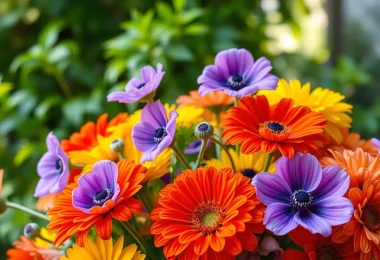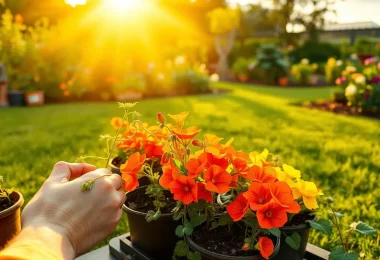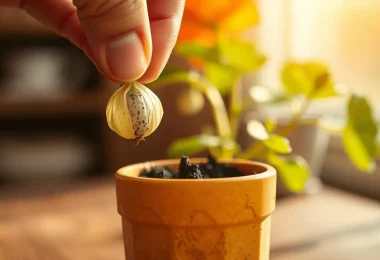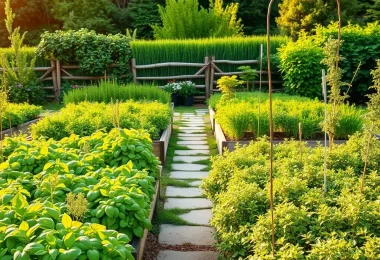Did you know habanero peppers are among the hottest chilies globally? Some varieties can reach up to 350,000 Scoville Heat Units. These peppers are not just hot; they’re also a delight for those who love spicy food. If you’re eager to grow your own habaneros, this guide has everything you need to know.
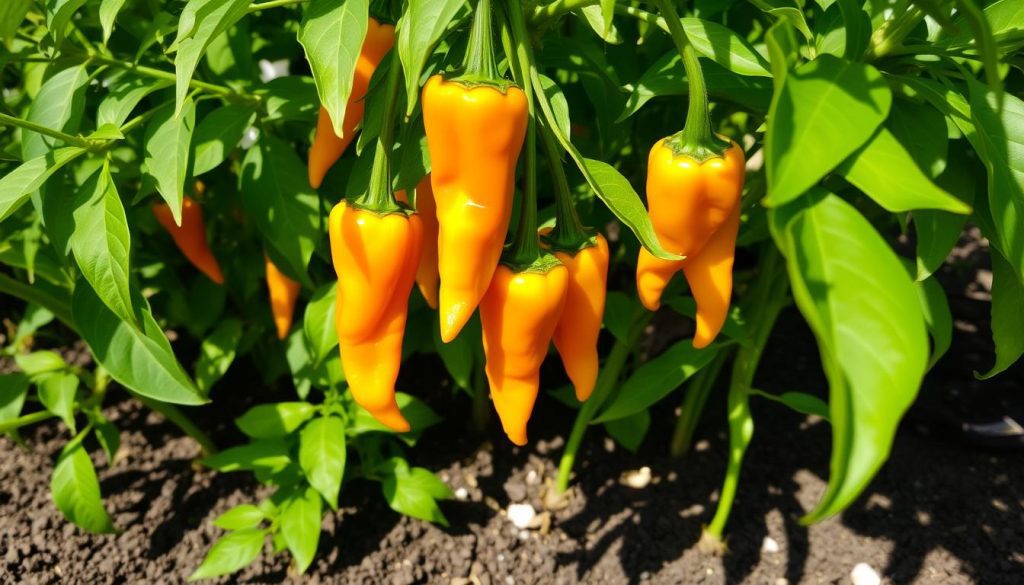
Key Takeaways
- Habanero peppers are among the world’s hottest chilies, with some reaching 350,000 Scoville Heat Units.
- This guide provides essential tips and techniques for successfully planting, growing, and caring for habanero peppers.
- Learn how to choose the right habanero variety, prepare the soil, plant seeds or seedlings, and manage pests and diseases.
- Discover expert advice on watering, fertilizing, pruning, and harvesting these flavorful and spicy chilies.
- Explore the diverse uses of habanero peppers in cooking and preserving for later enjoyment.
Introduction to Habanero Peppers
Habanero peppers are a favorite in cooking, known for their intense heat and fruity taste. They come from the Yucatán Peninsula in Mexico. This area has a rich history with these peppers, dating back to the ancient Mayans.
What are Habanero Peppers?
Habanero peppers are among the hottest, belonging to the Capsicum chinense species. They can have a heat level of 100,000 to 350,000 Scoville Heat Units (SHU). This makes them much hotter than jalapeños. Yet, they have a complex, citrusy taste that adds depth to many dishes.
The History and Origins of Habaneros
The Yucatán Peninsula in Mexico is where habanero peppers originated. The ancient Mayans grew them for centuries. They were a key part of Mayan cooking, used in sauces and marinades.
As time went on, habaneros became popular in the Caribbean and Latin America. Today, they’re grown all over the world. But the Yucatán remains a top producer, known for their flavor and heat. These peppers are used in many dishes, from hot sauces to desserts.
“Habanero peppers are a true culinary treasure, offering a unique balance of heat and flavor that can elevate any dish to new heights.”
Choosing the Right Habanero Variety
Habanero peppers come in many varieties, each with its own heat level and taste. Knowing the differences is key to picking the right one for your garden and taste buds.
The orange habanero is famous for its strong heat and citrusy flavor. But, there are also red and yellow habaneros with their own tastes. If you prefer less heat, the Scotch Bonnet habanero is sweet and fruity.
related: Everything You Need to Know About Scotch Bonnet Peppers
Think about how you want to use the peppers. The red habanero is great for hot sauces and spicy dishes. The yellow habanero is better for salsas, marinades, and even baked goods.
Exploring habanero varieties is fun for all gardeners. By knowing what each type offers, you can grow the perfect habaneros for your cooking and gardening.
Preparing the Soil for Habanero Planting
To grow delicious habanero peppers, you need to focus on the soil. These peppers love well-drained, rich soil that meets their special needs. Let’s look at what soil is best for habaneros and how to make your garden perfect for them.
Soil Requirements for Habaneros
Habanero peppers do best in slightly acidic soil with a pH of 6.0 to 7.0. This pH helps them get the nutrients they need. Also, the soil should have 5-10% organic matter for strong plant growth.
These peppers need soil that drains well to avoid waterlogged roots. A mix of sand, silt, and clay is ideal for their growth.
Amending the Soil for Optimal Growth
- Add compost or well-rotted manure to increase organic matter and improve drainage.
- If your soil is too acidic, add lime to adjust the pH.
- For clay soils, mix in sand or perlite to improve drainage.
- Spread a balanced, slow-release fertilizer in the soil before planting for steady nutrient supply.
With the right soil amendments, you can create a perfect spot for your habanero peppers. This ensures healthy plants and a great harvest.
“The secret to growing exceptional habanero peppers lies in the soil. By understanding and addressing their specific requirements, you can unlock the full potential of these fiery gems.”
Planting Habanero Seeds or Seedlings
Habanero peppers can grow from seeds or seedlings. Both methods need the right planting steps for a good harvest. We’ll look at how to start habaneros from seeds and transplant seedlings.
Starting Habaneros from Seeds
Starting habanero seeds indoors is a smart move. Begin by sowing seeds in a seed-starting tray or small pots. Use a mix that drains well. Cover the seeds lightly and keep the soil moist until they germinate, which takes 7-14 days.
After the seeds sprout, give them lots of sunlight. You can place them in a sunny window or under grow lights. Before moving them outside, harden them off for a week or two.
Transplanting Habanero Seedlings
- Choose a sunny, well-draining spot in your garden for habaneros.
- Prepare the soil by adding compost or organic matter to improve drainage and nutrients.
- Transplant the hardened seedlings 18-24 inches apart in rows or a grid.
- Water them well and use a balanced, slow-release fertilizer for a nutrient boost.
- Keep an eye on them in the first weeks and ensure consistent moisture to help them grow.
By following these steps for planting seeds or transplanting seedlings, you’re on your way to a great habanero harvest. With proper care, your habanero plants will flourish and give you their spicy flavor.
Habanero Plant Care
Proper care is key for your habanero plants to grow well. This includes watering, fertilizing, pruning, and staking. Learning how to care for your habaneros can lead to a great harvest.
Watering Habanero Plants
Habanero plants do best in well-drained soil and need regular, moderate watering. Make sure the soil is moist but not too wet. Water them deeply, about 1-2 inches, and let the soil dry a bit before watering again.
Change how often you water based on the weather and soil. Habaneros might need more water when it’s hot and dry.
Fertilizing Habanero Plants
Give your habaneros the nutrients they need for growth. Use a balanced, slow-release fertilizer or compost. Mix it into the soil around the plants, following the instructions.
Don’t over-fertilize. Too much can make the plants grow more leaves than peppers.
Pruning and Staking Habanero Plants
- Prune your habaneros often to help them branch out and get better air. Remove any dead, damaged, or sick leaves and stems.
- Stake or cage your plants to support them. This helps prevent branches from breaking under the weight of peppers.
By mastering habanero plant care, you’ll get a great harvest. Remember, each plant is different. Watch your habaneros closely and adjust your care as needed.
Watering and Fertilizing Habanero Plants
Keeping the right balance of water and nutrients is key for your habanero pepper plants. The right watering and fertilizing can greatly help. This ensures your plants grow well and produce lots of peppers.
Watering Schedule for Habaneros
Habanero plants need consistent watering. Water them deeply, about 1-2 inches into the soil, when the top inch dries out. This is usually every 2-3 days in summer and every 4-5 days in cooler months.
Don’t let the soil get too wet, as it can cause root rot. Check the soil moisture often and adjust your watering as needed. This keeps your habaneros healthy and well-hydrated.
| Watering Frequency | Soil Moisture |
|---|---|
| Every 2-3 days | Top inch of soil starts to dry out |
| Every 4-5 days | Cooler seasons |
Also, use mulch around your habanero plants. It helps keep moisture in and stops weeds. This improves your plants’ health and productivity.
Fertilizing Habanero Plants
Habanero peppers need a balanced fertilizer to grow well. Use a slow-release, organic fertilizer with a 10-10-10 or 5-10-5 ratio every 4-6 weeks. This gives them the nutrients for strong growth and lots of peppers.
For more root growth and flowers, use a water-soluble fertilizer with a 5-10-5 ratio. Apply this every 2-3 weeks, following the instructions carefully.
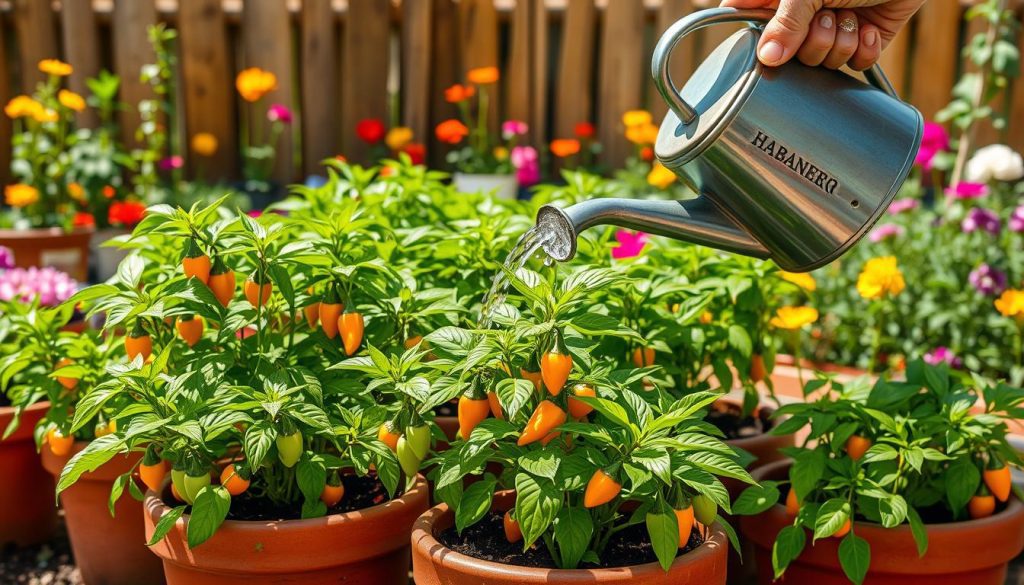
By following these tips, you’ll grow a successful habanero pepper crop. With consistent care, you’ll enjoy a flavorful and spicy harvest all season.
Pruning and Staking Habanero Plants
Pruning and staking are key for your habanero plants to grow well. Knowing when and how to prune helps with branching and air flow. It also boosts your pepper yield.
Pruning Habanero Plants
Start pruning your habaneros early. Remove dead, damaged, or diseased parts. This helps your plants grow strong and produce more peppers. Prune habaneros by cutting the top of the stems. This makes the plant grow more branches.
Staking Habanero Plants
Staking keeps your habaneros upright. Staking habaneros helps you reach the fruit easily. Use a strong stake like bamboo or metal. Tie the main stem gently to the stake.
| Pruning Tips | Staking Tips |
|---|---|
| Remove dead, damaged, or diseased leaves and stems Prune the tips of the main stems to encourage branching Prune regularly, especially during the early growth stages | Use sturdy stakes, such as bamboo poles or metal garden stakes Tie the main stem to the stake, allowing the plant to grow upright Provide support early in the growing season |
By using these pruning and staking tips, your habaneros will flourish. They’ll give you a rich harvest of spicy peppers.
Pest and Disease Management for Habaneros
Habanero peppers are loved for their bright flavor and spicy kick. But, they can get pests and diseases. It’s important to watch them closely and take care of them to keep them healthy.
Common Pests Affecting Habaneros
Many pests like aphids, spider mites, and thrips can harm habaneros. These tiny bugs can weaken your plants and reduce your pepper yield. Check your plants often and use organic soaps or neem oil to fight pests.
Diseases to Watch Out For
Habaneros can also get sick with diseases like bacterial spot, powdery mildew, and blossom end rot. These can cause leaves to turn color, plants to wilt, and fruit to rot. To avoid these, make sure your plants have good air, water them right, and pick disease-resistant types.
By watching closely and using the right pest and disease control, you can keep your habaneros healthy. This way, you’ll get a big harvest of these tasty peppers.
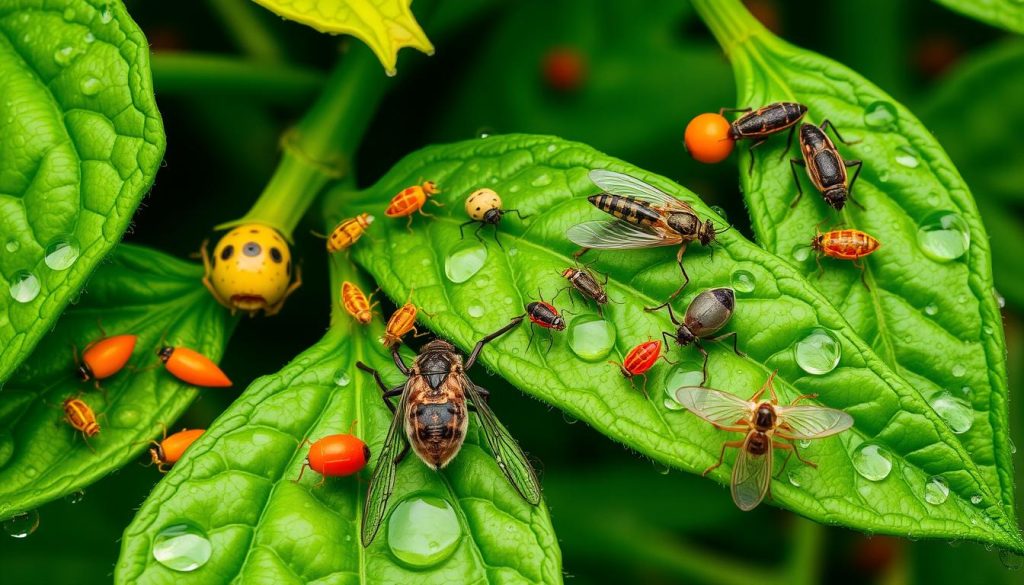
| Pest | Symptoms | Management |
|---|---|---|
| Aphids | Leaves and stems covered in small, sap-sucking insects | Use insecticidal soap or neem oil |
| Spider Mites | Fine webbing, leaves turn yellow or brown | Spray with water or use miticide |
| Thrips | Leaves and flowers become distorted and discolored | Apply insecticidal soap or neem oil |
It’s crucial to manage pests and diseases well to keep habaneros healthy. By being proactive and using the right methods, you can enjoy a big harvest of these delicious peppers.
Harvesting and Storing Habanero Peppers
Knowing when to pick your habanero peppers and how to store them is key. These peppers are known for their intense heat and bright colors. Proper timing and care can preserve their unique qualities.
When to Harvest Habaneros
Habanero peppers are ready when they’re fully grown and have a deep color. This usually takes 70-100 days after transplanting. Look for peppers that are 2-3 inches long and shiny.
Harvest them in the morning to keep their flavor and heat. If you’re storing them, pick them when they’re slightly under-ripe. They’ll ripen and get spicier after picking.
Storing Habanero Peppers
- Refrigeration: Store fresh habaneros in the fridge for up to two weeks. Use a resealable bag or airtight container to keep them moist and crisp.
- Freezing: To freeze, wash and dry the peppers. Freeze them on a baking sheet, then put them in an airtight container or bag.
- Drying: You can dry habaneros for longer storage. String them and hang them in a cool, dry spot. Or, use a food dehydrator for faster drying.
Storing habaneros properly is crucial for keeping their flavor and heat. By following these tips, you can enjoy your habanero harvest for months.
Using Habanero Peppers in Cooking
Habanero peppers are loved for their intense heat and fruity taste. They are great in many dishes, from spicy sauces to tasty meals. They bring bold and complex flavors to your cooking.
Recipes and Dishes with Habaneros
Habanero peppers add excitement and depth to many dishes. Here are some tasty ways to use them:
- Habanero-Infused Salsa: Mix habaneros with tomatoes, onions, cilantro, and lime juice for a zesty salsa.
- Habanero-Mango Chutney: Blend diced habaneros with mango, vinegar, and spices for a tangy condiment.
- Habanero-Lime Grilled Chicken: Marinate chicken in habaneros, lime juice, garlic, and herbs for a spicy dish.
- Habanero-Infused Honey: Soak habanero slices in honey for a sweet-and-spicy topping.
Habanero peppers bring a bold, fiery kick to your cooking. Try these peppers and find your new favorite habanero recipes and cooking with habaneros.
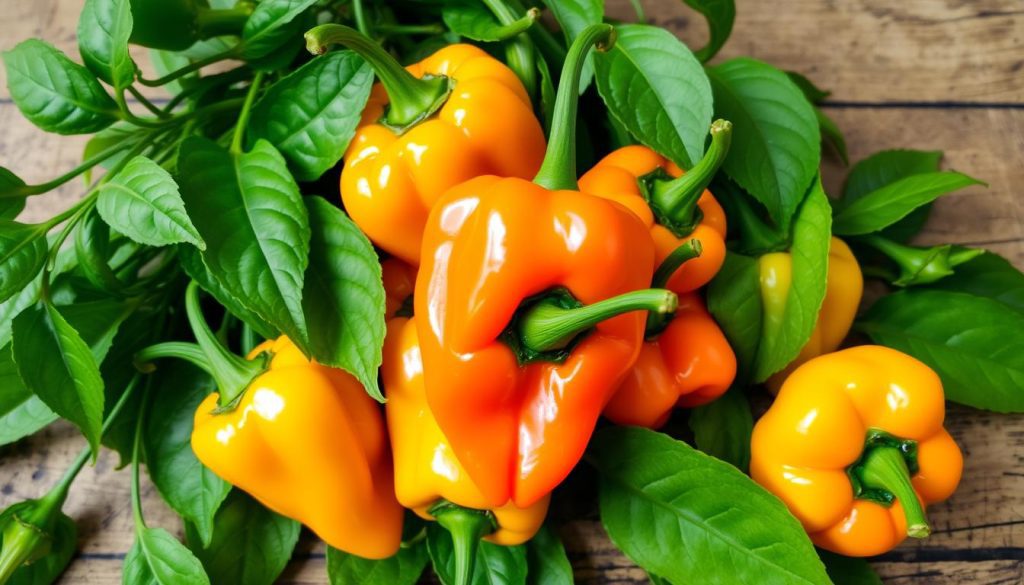
“Habanero peppers are the perfect balance of heat and flavor. They instantly elevate any dish with their unique fruitiness and fiery punch.”
Preserving Habanero Peppers for Later Use
Preserving your habanero peppers is a great way to enjoy their flavor and heat all year. You can pickle, dehydrate, freeze, or ferment them. Each method has its own benefits for keeping these peppers fresh.
Pickling habaneros is a popular choice. It not only keeps them fresh but also adds new flavors. Just slice or dice the peppers, then soak them in a vinegar brine with spices. Store them in the fridge for months to use in many dishes.
Dehydrating habaneros removes moisture, making them last longer and more intense. You can turn them into a powder for seasoning or sauces. This method concentrates the pepper’s heat.
- Pickling preserves habaneros in a flavorful brine
- Dehydrating creates a shelf-stable, concentrated pepper powder
- Freezing retains the fresh flavor and texture of habaneros
- Fermenting unlocks unique flavor profiles and health benefits
Freezing is another great way to keep habanero peppers fresh. Just slice or dice them and put them in a sealed container. They’ll stay good for a year. Use them in cooking and baking just like fresh ones.
Fermenting habaneros is a unique method. It makes them spicy and probiotic-rich. By fermenting them in a salt brine, you get a flavorful condiment for many dishes.
Choosing how to preserve habaneros lets you enjoy their intense heat and flavor all year. Try different methods to find what you like best.
Tips and Tricks for Growing Habaneros
Growing habaneros is more than just planting seeds and waiting. To get the most out of your habanero growing, try these expert tips. They’ll help you overcome common challenges and grow a lot of flavorful peppers.
Maximize Habanero Yields
To get a lot of habaneros, follow these steps:
- Prune your plants often to make them bushy and more productive.
- Put your plants in a sunny spot to get 6-8 hours of direct sunlight daily.
- Feed your plants with a balanced, nutrient-rich fertilizer to help them grow and produce more peppers.
Manage Habanero Pests and Diseases
Habaneros can get pests and diseases. Keep an eye out and act fast to protect your plants:
- Check your plants often for pests like aphids, spider mites, or leaf-footed bugs. Get rid of them quickly.
- Watch for diseases like bacterial spot, anthracnose, and powdery mildew. Take steps to prevent and treat them.
- Make sure there’s good air flow around your plants to prevent diseases.
Extend the Habanero Harvest Season
To keep growing habaneros longer, try these ideas:
| Technique | Description |
|---|---|
| Succession Planting | Plant habanero seeds at different times to keep getting peppers all season. |
| Protective Structures | Use row covers, greenhouses, or cold frames to keep your plants safe from cold and extreme weather. |
| Proper Overwintering | With the right care, you can keep habanero plants indoors over winter. Then, move them outside in spring for an early start. |
By using these tips, you’ll grow a lot of delicious habaneros. Happy growing!
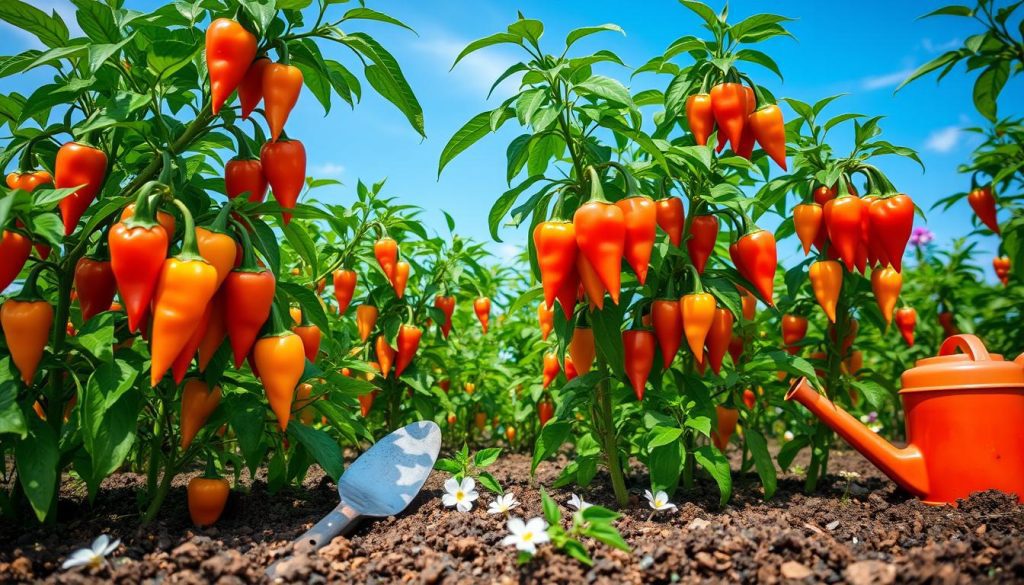
Conclusion
In this guide, you’ve learned key tips for growing habanero peppers. You now know how to pick the best variety, prepare the soil, and care for your plants. You also know how to harvest your peppers.
Start growing habaneros and add their unique flavors to your cooking. Whether you’re new to gardening or have experience, you’re ready to grow these peppers. Enjoy the process and the delicious results. Happy growing!
Use what you’ve learned to have a great time growing habanero peppers. Check back to the guide when you need to. Feel free to try new things and adjust for your area. The world of habanero peppers is full of possibilities.
FAQ
What are Habanero Peppers?
Habanero peppers are known for their intense heat and fruity taste. They come from the Yucatán Peninsula in Mexico. They have a long history, dating back to ancient Mayan civilizations.
What are the different Habanero Pepper varieties?
There are many Habanero pepper varieties. Each has its own heat level and flavor. You’ll find the traditional orange habanero, red habanero, and the Scotch Bonnet among others.
What are the ideal soil requirements for growing Habanero Peppers?
Habanero peppers need well-draining, nutrient-rich soil. The soil should be slightly acidic with high organic matter. It should also have a balanced nutrient mix to support the plants.
How do I start Habanero Peppers from seeds?
Start habanero seeds indoors and then move them outside when ready. Make sure the soil is right and the timing is perfect. This will help you get a good harvest.
How do I care for my Habanero Plants?
Proper care is key for habanero plants. Keep them watered right, use the right fertilizers, and prune them. Staking is also important to support the plants.
How do I manage pests and diseases affecting Habanero Plants?
Habanero plants face pests like aphids and diseases like bacterial spot. Knowing how to manage these issues is crucial. It keeps your plants healthy and productive.
When should I harvest Habanero Peppers?
Harvesting habanero peppers at the right time is important. Look for the right color and firmness. This ensures the best quality and flavor.
How can I preserve Habanero Peppers for later use?
честные казино с быстрыми выплатами
бездепозитные бонусы казино
играть в лучшем казино на деньги
база казино с бездепозитным бонусом
онлайн казино России
casino oyunu
You can preserve habanero peppers through pickling, dehydrating, freezing, or fermenting. These methods help you enjoy your habaneros long after they’re picked.
What are some tips and tricks for growing successful Habanero Peppers?
Improve your habanero growing with expert tips. Learn how to maximize yields, manage challenges, and use your harvest creatively.





